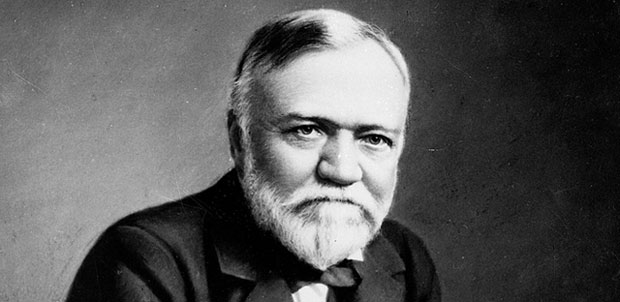
Andrew Carnegie also known as the ‘steel king of America’ was a business tycoon who made his wealth largely from the steel industry. He was also a large-scale philanthropist whose life story is often referred to as ‘rags to riches’.
Andrew Carnegie was born to a hand loom weaver in Dunfermline, Scotland on 25th November 1835. After the decline of their handloom business the family immigrated to Pennsylvania, United States. Starting off as an ordinary bobbin boy in a cotton factory, Carnegie worked many other jobs that included a Western Union messenger, a telegraph operator and finally as a superintendent of Western Division of Pennsylvania Railroad. Carnegie had a lot of potential and an urge to do something much greater. While still working at the Railroad, he made an investment in a railway sleeping car manufacturer. That was the first step towards his remarkable entrepreneurship. He founded ‘Keystone Bridge Company’ in 1865 and his first steel company in 1873 which expanded quickly. At the time of its sale in 1901 to J. P. Morgan, another steel titan, the company was worth more than 400 million dollars.
Most of Carnegie’s wealth was acquired from the steel business. He was the first and only person in the country who controlled wide-ranging integrated iron and steel operations. His innovations comprised of the inexpensive and efficient production of steel on a mass level and taking on and familiarizing the Bessemer process of making steel. Because of him, the United States steel output was far greater than the UK. His empire of steel incorporated Edgar Thomson Steel Works, the Lucy Furnaces, the Union Mill, the Union Iron Mills, the Keystone Bridge Works, the Hartman Steel Works, the Frick Coke Company, Scotia ore mines and the Pittsburgh Bessemer Steel Works.
Andrew Carnegie also gave huge amounts of his wealth for the betterment of the society. He contributed 40,000 dollars for the formation of a library that would be free for all. He made commodious swimming baths for the people of Dunfermline in 1879. He also donated half a million dollars to Bellevue Hospital Medical College, which is now called New York University Medical Center. This money was used to form a test center now called the Carnegie Laboratory. He wanted Philippines to become an independent country. As the United States had bought it from Spain for almost 20 million dollars, Carnegie offered its people 20 million so they could buy it back from the U.S. However nothing really happened in this regard.
He asked Napoleon Hill who was a journalist to conduct interviews of influential people in the hope to find out the common thing between them that had led them all to success. This work was published after Andrew’s death as ‘The Laws of Success’ in 1928 and then as ‘Think and Grow Rich’ in 1937. Carnegie also contributed to various other periodicals such as ‘Triumphant Democracy’ (1886), ‘The Gospel of Wealth’ (1889), ‘Round the World’ (1884) and ‘The Secret of Business is the Management of Men’ (1903).
Andrew Carnegie died on 11th August 1919. He has been esteemed with many legacies and honors.
